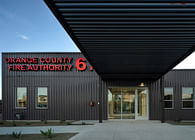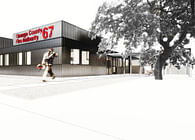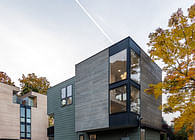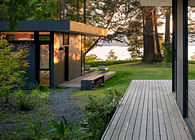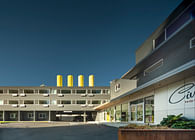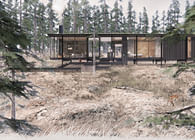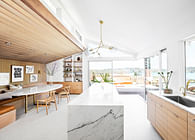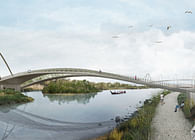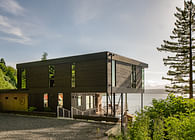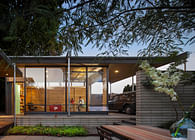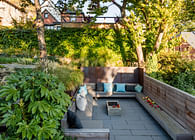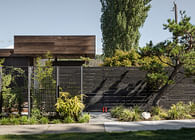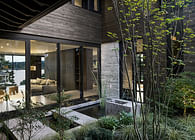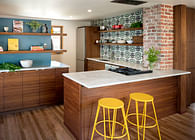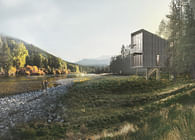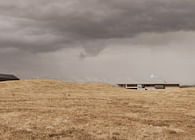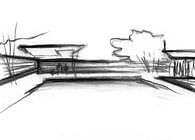
Seattle, WA
Floating above a meadow, Whidbey Uparati seeks to minimize visual and physical impact on the natural landscape by blending into the site rather than asserting itself upon it. Upon approach, the meadow vegetation and flowering trees surround a winding path up a steady slope to the house. The house is a place for family bonding, meditation, and uparati – “stillness” in sanskrit.
The 1,880-square-foot house perches above the natural surroundings. Grasses and flowers surround a muted wooden building with generous windows, connecting the house audibly and visually to the surrounding nature. The careful siting of the house takes advantage of the sectional character of the land, lessening the visual impact typical of more traditional architecture on the island, and crafting a modern interpretation of the natural landscape in which it resides.
The owners often travel back home to India to partake in meditative retreats. They requested a retreat that could serve as an escape from urban living and as place for meditative contemplation. The location and design allow the couple, their two sons, cat and dog, to play within the rhythmic sway of the meadow grasses and stunning views.
The house consists of two bedrooms, two bathrooms, a multi-purpose room, and a living room and kitchen for communal activities. The transparency of the house invites residents to spend time together and enjoy the rural background, while the house’s location on the highest part of the lot allows for panoramic views of surrounding Useless Bay and the Olympic Mountains. During the warmer seasons, the owners can also enjoy a generous west facing deck.
The experience of the house starts at the journey from Seattle. The owners cross the pearlescent waters of the Puget Sound and head into the outlands of rural Whidbey Island. A Sugar Maple tree lined driveway beckons them closer, winding up a steady slope, through meadow vegetation – Blue Oat Grasses, Mexican Feather Grasses, Adagio Maiden Grasses - and summer blooming flowers – Cone Flowers and Flowering Sage. “We wanted to ‘rewild’ the site through landscaping,” says Jody Estes, the lead landscape designer. “It was important to remove invasive species and to create a plan for forest restoration.”
At the end of the path, a set of stairs usher the owners up into the house at its highest point. The low ceiling and neutral palette, creates a moment of compression before stepping down into the more spacious living room and kitchen. As the visitors travels further into the heart of the building, the more transparent the house becomes, floor-to-ceiling windows framing the Pacific Northwest view.
Wittman Estes designed the house to be simple to construct, reducing the construction timeframe and the overall project cost. The result is a rational façade as columns frame views and experiences at consistent 12’ and 16’ intervals. “The simple structure follows the logic of a grid,” says Matt Wittman, the architect.
The structural engineering is supported by a Ground Frame foundation system to eliminate using concrete for the foundation of the house. This enabled the architects to avoid the use of concrete altogether and accentuate a light touch on the landscape. The Ground Frame foundation reduces the carbon footprint by 77% relative to the equivalent concrete foundation. The micro pile technology acts like roots for the house, anchoring it to the ground both structurally and visually.
Using a rigid structural framework creates a consistent interior experience as well, each room is proportionally related and also designed to the particular dimensions needed for sleeping, living, cooking, and meditating. Each room has a connection with the landscape beyond, shaping a peaceful experience throughout the space.
With an interest in film, the clients wanted the house to provide a cinematic visual composition both for the interior and the exterior. The sequence of the interior spaces allows for light and shadow to shift the perspective and mood of each room like scenes in a Roger Deakins film. The interior palette draws on neutral tones as its base to allow for the residents’ objects and everyday items to create punctuation of color and visual dynamics.
The house is constructed using natural materials. The exterior uses a muted cedar siding. The interior spaces are a study in simple wood details – plywood walls, cedar tongue and groove ceiling, and a engineered wood floor. This draws the eye outward, through the windows, and toward ever-changing seasons. The living space is open, defined by warm wood and stainless steel fixtures, and intimately connected with the landscape by the floor-to-ceiling windows.
“Our goal was to be sensitive and build as delicately as we could on the ground,” says Nikki Sugihara, project manager. “That includes selecting natural materials and allowing the wood figuring to express itself.”
The Whidbey Uparati house is defined by its simple structure and connection to the landscape. A porch is screened by wood slats for a more intimate and protected entry. A west deck highlights the views to Useless Bay. A courtyard features a reflecting pool, sheltered by a Stewartia tree.
A walking path that meanders around the perimeter of the five-acre lot. In a future phase, the walking path will lead into the forest to a meditation pavilion.
Overall, the house is a contemporary retreat that offers a comfortable and meditative connection with the natural surroundings. The quiet nature of the house’s material palette and structural simplicity allows its most coveted quality to be heard loud and clear – in stillness we can hear nature speak.
Status: Unbuilt
Location: Whidbey Island, WA
Firm Role: Architecture, Interiors
Additional Credits: Builder: JADE Craftsman Builders LLC
Structural Engineer: J Welch Engineer


